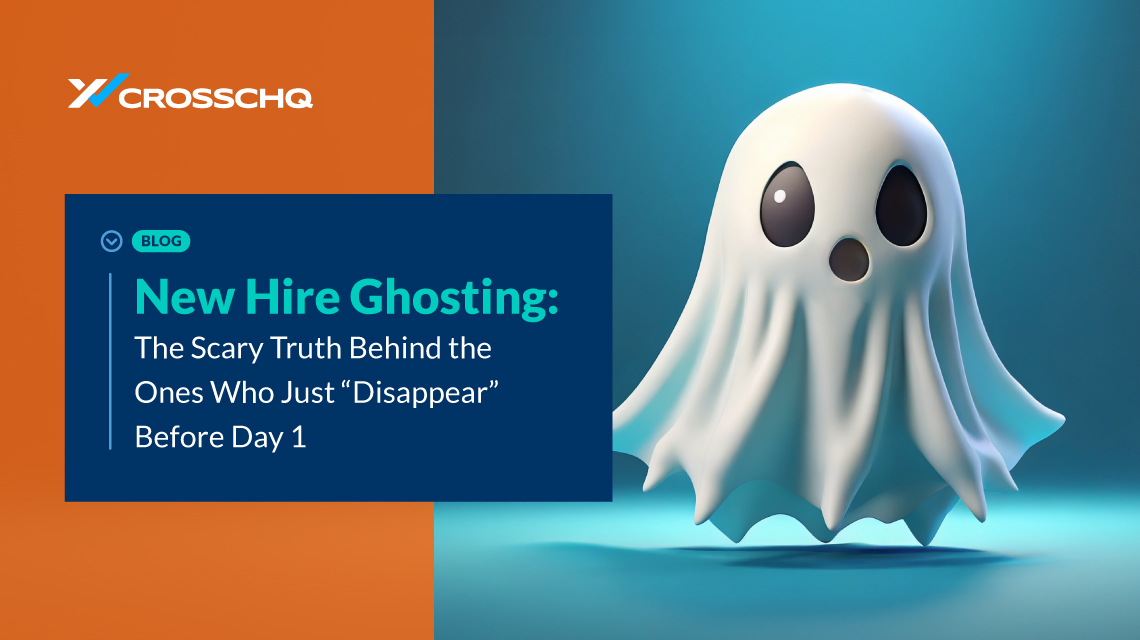

Crosschq Blog
New Hire Ghosting: The Scary Truth Behind the Ones Who Just “Disappear” Before Day 1

Move over, quiet quitting: ghosting is the new trend. At least, that’s what employers are saying as they heave a sigh of relief at an offer acceptance only for it to turn into a gasp of horror when the candidate fails to show up on Day 1.
While around 14% of job-seekers admit to having ghosted a company at some point in the hiring process, the real pain point happens when a candidate accepts an offer-then simply disappears.
While ghosting has traditionally been seen in lower-wage, high-volume hourly roles in high-turnover industries such as retail and hospitality, this troubling trend has become more widespread in the last year due to the consistently tight labor market, particularly in technology and health care jobs.
What’s happening between offer acceptance and your new hires' first day? Why would someone accept a job then just disappear? Most importantly, how can you figure out what is causing Day-1 ghosting at your company and put an end to it?
What Exactly Is Ghosting?
Ghosting happens when your candidate accepts your offer, and then… simply never comes into work. This “ghosting”, also referred to as “quick quitting” or “no-show-Day-1”, is becoming more and more common, and it’s a massive concern for recruiters, managers, and HR departments across the country.
According to reporting from CNBC, 1 in 5 people have accepted a job offer and ghosted on the first day.
- 19% accepted a verbal offer but never signed the paperwork
- 22% accepted the offer and didn’t show up to work on their first day.
Why don’t these new hires just pick up the phone or shoot off an email? Apparently, it’s just not that easy:
- 26% of job seekers say they weren’t comfortable admitting they’d changed their mind
- 13% say they had general issues with getting in touch with their recruiter
- 11% say they didn’t know what to do after their change of heart, so they disappeared
Who’s Ghosting on Day 1?
Before everyone raises their hand and shouts “Gen Z!” better walk that back and try again. According to one survey, the average “ghost” has a median age of 34. Ghosts aren’t lazy or chronically unemployed people either; 70% of those who ghost are currently fully employed.
However, this phenomenon does seem to be happening for entry-level positions more than for other tiers of employment. In many cases, such an applicant might have used an “easy-apply” function to put out many applications, then accepted offers as they came in, choosing their “best option” after the fact.
So why are up to one in five people walking away from a job they landed before they even spend a minute working at it? Is it lack of candidate commitment or loyalty? Is it a company branding problem? Is it a play at wait-and-see for something better? Let’s look at the possible motivations behind this frightening trend.
Why Are New Hires Ghosting?
A lot of the knowledge surrounding ghosting is biased and/or anecdotal. Companies who don’t or can’t follow-up with candidates to find out why they bailed may assume the candidate was just a “bad hire” to begin with and think they avoided a bullet.
However, what recruiters do say they’ve heard first hand that some new hires end up bailing before their first day on the job for three major reasons:
1. Communication Failure

When an offer goes out, and the candidate accepts but does not hear back an enthusiastic response and welcome, they may feel that they aren’t really wanted or that they don’t fit with the company culture.
Alternatively, candidates may be wary of conflict or uncomfortable situations. They might find it easier to fade away quietly than to contact an employer and say they’ve changed their minds.
What to do: Use TalentWall to keep recruiters, hiring managers, and HR on the same page, allowing for quick decisions and minimizing any unnecessary wait-time for candidates. Use automation to trigger immediate welcome messages and “next steps” emails to go out to candidates who accept offers.
Keep talking to your new hires from the day they accept your offer until the day they start and beyond. Finding and keeping great workers is easier when you’re keeping your finger on their pulse the whole way through. Track and optimize critical recruiting benchmarks to make sure you’re meeting candidate’s needs as well as your own.
2. A Lengthy Hiring Process

Every phase of the hiring process takes time. To those on the recruitment side, every step is a logical and necessary one to narrow the field, but to candidates waiting for a response to their application or a call after an interview, it can feel like forever.
This can mean the first offer to come in gets accepted, and then when a second offer arrives, the new hire is too embarrassed or too irritated to both to explain to company A that they’ve gone with company B instead.
An article from CNN Business suggests overhiring by 10-20% to adjust for “Day-1-no-shows”, but this is far from practical when you’re trying to build a solid team and create efficiency (vs add noise) to your already busy hiring queue. Instead, think about how you can speed up your hiring process without sacrificing Quality of Hire.
What to do: Use TalentWall to streamline your hiring processes. Use 360 Reports to surface top talent early in the process, and gather information that can be used in interviews. Improve your hiring funnel using AI and automation wherever and whenever possible without losing the human touch.
Once you’ve completed interviews, make an offer quickly and with confidence. If several rounds of interviews are needed, stay in constant communication with your top candidates to let them know you are still interested in hiring them.
3. Disorganization and Confusion
Finally, many new hires accept an offer, and decide to pass after the fact because of a company’s disorganized approach to onboarding or confusion over their new role. If the offer letter isn’t quickly followed up with clear, coherent guidance, a new hire can lose faith.
Likewise, if the original job description says one thing when it comes to responsibilities, but the onboarding email seems to be completely disconnected from those expectations, a new hire might feel the job was misrepresented and that they aren’t as good a fit as they thought.
What to do: Write great job descriptions, then use 360 Reports to let candidates highlight their strengths for better applicant/ role matching. Use TalentWall to ensure that onboarding communications to new hires go out both promptly and in the correct order, and integrate employees into the job as soon as they accept the role.
It's up to hiring managers to make sure that the candidate is getting enough information about the job and the company. You can’t ever take for granted that everybody who goes through the process wants to work for you.
4. Received a Better Offer and/or Pay
In a competitive labor market, if you don’t come through with a solid offer, your candidate may choose to accept another with better pay, benefits, and/or work-life balance. Are you aware of the value of the type of person you need to fill a specific role?
Don’t be that employer who spends more than the anticipated annual salary just to find and hire someone who comes in at a 20% lower pay point than their peers. It’s not even just about the money - what can you offer in the way of flexible scheduling, PTO, and other perks?
What to do: Use 360 Reports to get a solid grasp on what’s important to each candidate, and follow up in your interviews to nail down what it takes to keep your top picks invested in continuing the recruitment process. If you feel you have competition for their interest, ask them to come back to you before accepting another offer.
Pay close attention to the parts of the self-reference report where your candidate highlighted their strengths and competencies. Make it clear you want to help them increase their skill sets and make use of their strengths so they can grow with your company.
What Happens When New Hires Ghost?

If you’ve hired someone who doesn’t show up on Day 1, all that time and effort has effectively been flushed away. You trick or treated, and boy, did you get tricked. It’s not just the recruitment costs, though - it’s the cost of morale among your existing employees (and you and your recruiting teammates as well).
Imagine your best worker helping to keep your company afloat by doing the work of two people for weeks or even months. You keep telling them you are hiring someone to fill the missing role, and finally you have good news: their new coworker will be starting Monday.
But on Monday, nobody shows up. Your disillusioned employee is left still doing the work of two people with no end in sight. Guess what happens? That’s right. Your best worker quits, and now you’re trying to fill TWO new positions instead of one. And how is the morale of the hiring manager? He or she was finally receiving that new, critical team member after searching high and low, only to find out they have to start again. Is your hiring manager now at risk of leaving or rushing to make the next hire again, regardless of quality? All spooky thoughts, right?
How to Recognize Potential-Ghost Behavior

Our clients have had enormous success using TalentWall and Crosschq to reduce time to hire, improve the number of hires who show up for Day 1, and retain a higher number of employees past the 30 day mark, the 90 day mark, and beyond. Check out these success stories:
More Engagement = More Committed
One client was able to use the 360 self assessment as an engagement signal that reflected a level of interest and motivation of those candidates who filled it out compared to those who didn't fill it out. The candidates who complete their self reference have a higher likelihood of showing up on the job and staying longer, meaning higher returns for our client’s placements.
Why? Crosschq 360 can support highly transactional, high turnover, fast placement positions for staffing companies or large organizations. The self assessment allows candidates to:
- Feel more involved
- Get a chance to highlight their skills,
- Engage references better
360 allows you to reduce your time to hire and streamline your process. A faster turnaround to an offer gives the candidate less time to collect other offers and bail on you before they even start.
Reduced Ghosting and Quick Quitting with Self Assessments
Another client started using the 360 self assessment, and found that it reduced ghosting / quick quits significantly. They received feedback that their candidates felt immediately more involved in the process. Since they were given the chance to highlight their strengths, they were more confident and less likely to just disappear.
Longer Candidate Response Delays = More Likely to Turn Over for Cause
A client who used 360 honed in on the time taken to engage with and complete candidate and reference surveys using perspective validity studies. They found that if it took a candidate more than a day to complete their self reference survey after receiving it, and the candidate’s references also took more than 1-3 days to complete their surveys, the new hire would be more likely to turn over for cause in their first year of employment.
Ring Our Doorbell - We’re Friendly!

Are you ready to start getting more treats than tricks out of your hiring funnel and into your workforce? Get a free demonstration chrof how Crosschq can help your company get rid of the problem of new hire ghosts. Contact us today.
Take the Guesswork
Out of Hiring
Schedule a demo now



%20-200x43.png)







.png)